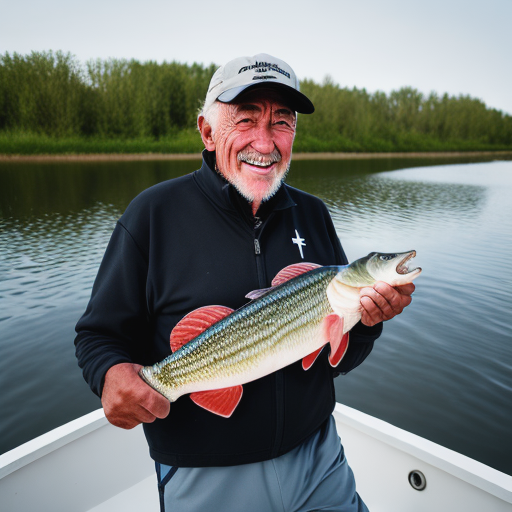Switch casting is a handy skill for making precise casts in narrow places. It’s especially useful when you’re stream fly fishing in tight spots. To switch cast well in confined areas, you need certain tips and techniques. This article will cover those to help you get better at it.
Key Takeaways:
- Switch casting is a valuable skill for fishing in small areas and making precise casts in restricted spaces.
- Compact casting techniques are crucial for effective switch casting in tight quarters.
- Precision casting is essential for navigating narrow spots during stream fly fishing.
- Mastering switch casting will improve your ability to fish in confined spaces and land more fish.
- By implementing these expert tips, you can enhance your switch casting skills for small water fishing.
The Benefits of Switch Rods
Switch rods are unique double-handed rods that are light. They have many benefits for those who fish. These rods are great for both two-handed and overhead casting.
They let anglers try different ways of casting. This means you can fish in new ways. Plus, it makes fishing more enjoyable.
Switch rods are perfect for smaller waters. Their design makes them easy to use in tight spots. They’re much better in small areas compared to long spey rods.
“Switch rods are a game-changer when it comes to fishing in small water. They allow me to make precise casts even in the tightest spaces, giving me a real advantage when targeting elusive trout.” – Alex Fisher, Fly Fishing Enthusiast
This type of rod also makes fishing more interesting. You can use them for many fishing methods. This includes using different fly patterns.
Using one rod for various fishing styles is exciting. It makes your fishing trips more fun and engaging.
To show you how good switch rods are, check out this comparison table:
| Advantages of Switch Rods | Traditional Single-Handed Rods |
|---|---|
| Effective for different fishing techniques | Limited versatility |
| Lightweight and suitable for small waterways | May be too long and cumbersome for tight spaces |
| Adds variety and fun to your fishing experience | Limited casting options |
As seen in the table, switch rods are great for anglers. They offer many benefits, especially in small waters. They bring new fun and variety to fishing.
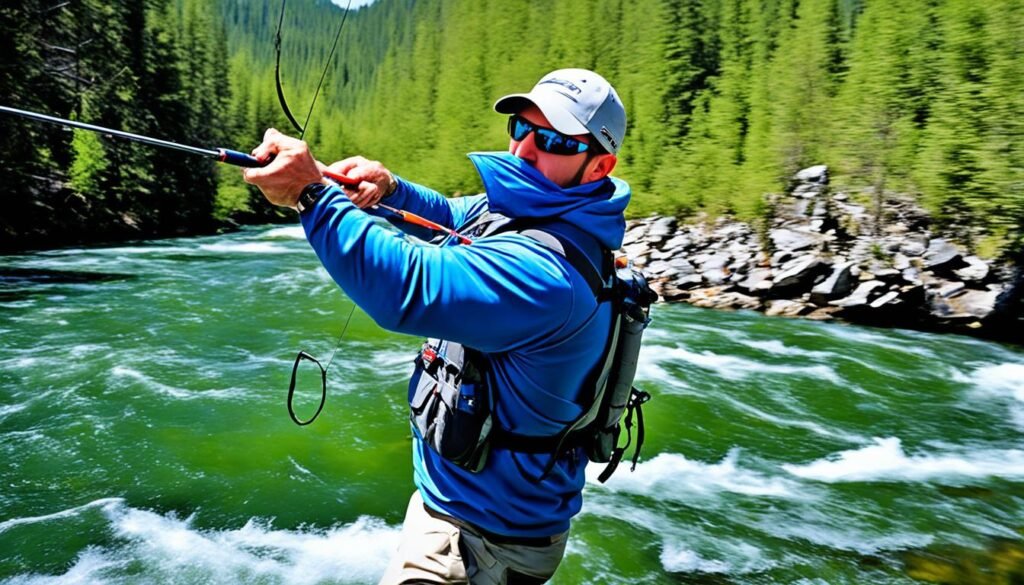
Becoming a Better Spey Caster with Switch Rods
Switch rods are great for improving spey casting skills. They work well all year, unlike other spey rods. These rods are perfect for practicing on smaller waters. This lets you improve your skills anytime.
Switch rods are unique because they demand precision. The smaller size means you need to focus on your technique. Mastering a switch rod will improve your spey casting in all fishing situations.
Using a switch rod can perfect your casting. Their size makes you focus on controlling and moving your rod better. This helps improve your accuracy and make your casts more powerful and efficient.
Improving Spey Casting Techniques with Switch Rods
Here are some tips to improve with your switch rod:
- Master the Spey Casting Basics: Make sure you know the basic spey casting techniques. These are key for any type of spey fishing. They form the foundation for using switch rods and other spey setups.
- Fine-Tune Your Timing and Power Application: Focus on when you apply power and your timing. This is crucial for good line control and distance with a switch rod.
- Practice with Different Switch Rod Line Setups: Try out various line setups. Find what works best for how you cast and the places you fish. The right setup can really improve your switch rod’s performance.
- Work on Your Loop Control: Loop control is a big deal in spey casting. Practice to make your loops tight and effective. This will help with your casting accuracy and how your fly lands.
- Seek Guidance from Experienced Casters: Getting tips from pros can be a game-changer. A lesson or clinic could really help you get better faster. Experienced casters can give you insights that make a big difference.
Putting in time and focus with your switch rod can really up your game. Becoming a better angler takes practice and learning. Keep at it, and you’ll see improvement in no time. Enjoy the journey of mastering switch rods for great spey casting.
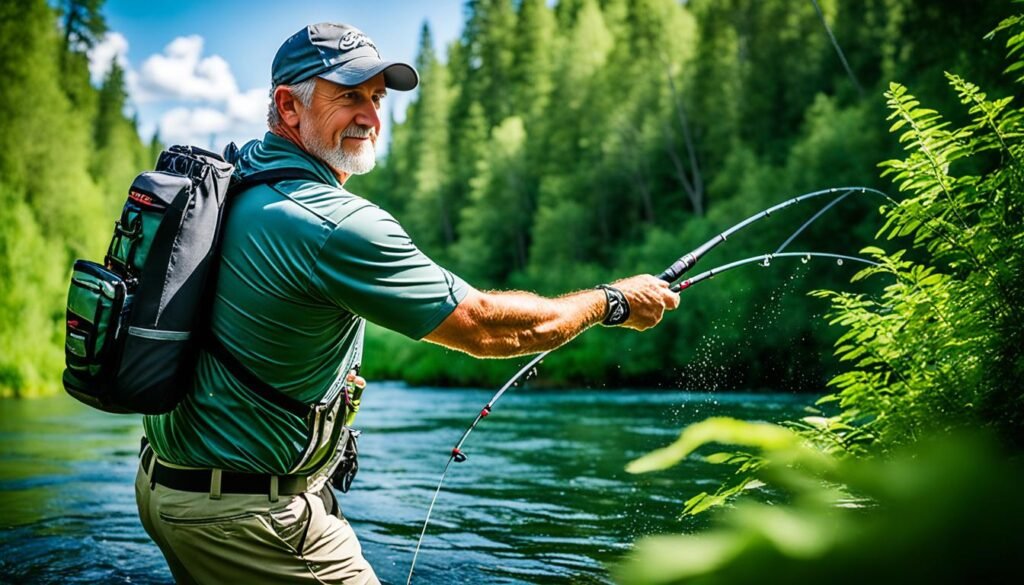
Practicing Loop Control for Switch Casting
Mastering loop control is key to successful switch casting. It affects your loop’s size and shape. This, in turn, impacts how well your cast performs. Adding specific exercises to practice can greatly help.
The Importance of Casting and Loop Control
Casting and loop control matter most in switch casting, above fly patterns. Though choosing the right fly is key, without good casting technique, even the best fly won’t work well. Focusing on casting and loop control ensures you make accurate, effective casts, improving your fishing chances.
Loop Control Exercises
You can do many loop control exercises to better your switch casting skills. Casting through a Hula Hoop is one such exercise. It acts as a guide, helping adjust your loop’s size and shape. Regularly doing this exercise improves your casting precision.
Learning Loop Control Without a Fly Rod
Improving loop control is possible even without a fly rod. You can work on hand movements and casting motion without the rod. This builds muscle memory and sharpens your loop size and shape control. It’s a practice that can be done anywhere, keeping your casting skills sharp.
Switch casting success hinges on good loop control. By focusing on proper casting and loop control, you can boost your accuracy and presentation, improving your overall switch casting.
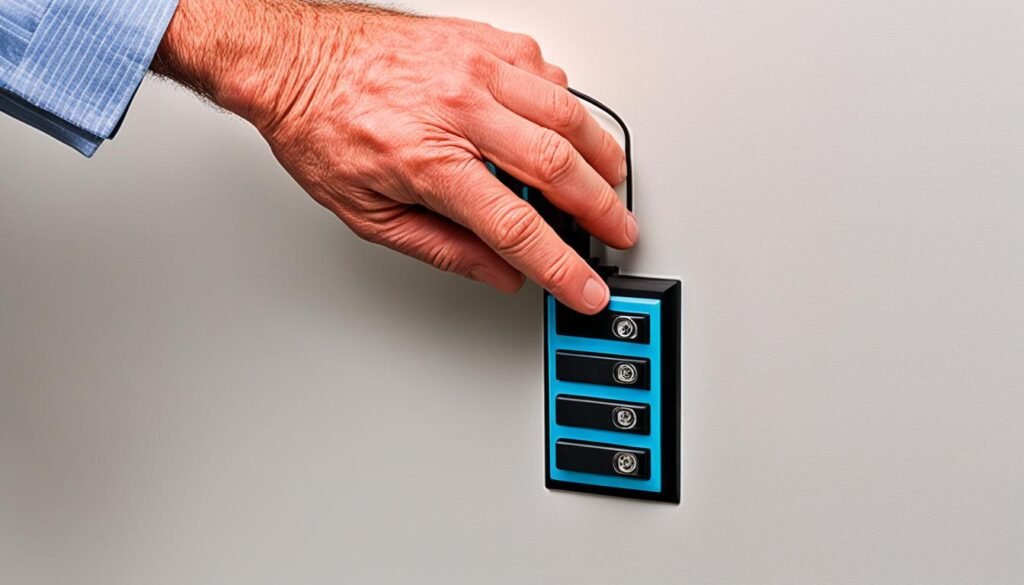
| Questions to Ask | Fly Patterns vs. Casting Techniques |
|---|---|
| What are some common mistakes to avoid when it comes to loop control? | How can the proper casting technique compensate for using simpler fly patterns? |
| What role does loop control play in achieving accurate presentations? | How can the skill of loop control impact the success of different fly patterns? |
| What are some tips for achieving tighter loops in switch casting? | How can casting technique enhance the effectiveness of specific fly patterns? |
Tips for Loop Control in Switch Casting
To make your switch casting loops tighter, focusing on certain strategies and practicing is key. This can really boost your casting accuracy and efficiency.
1. Hauling for Tighter Loops
Use hauling to create more energy in your cast and better control your loops. When you haul, you pull on the line with your hand. This pull increases the speed of the line and forms tighter loops. Try different hauling ways to see what suits you best.
2. Grip and Rod Tip Path
How you hold your rod and the path of your tip are crucial for loop control. A good way to get tighter loops is by holding the rod with your index finger on top. This grip limits your wrist movement and keeps the rod tip straight. A straight rod tip path means you make consistent, tight loops.
Changing your grip, like using your thumb on top, allows for wider loops. You can adjust your grip based on what you need for the situation.
3. Importance of Rod Tip Path
Knowing where to stop the rod tip is essential for loop size and shape. Try to stop the rod tip at the height you want. Stopping the tip too high makes bigger loops, and too low makes them smaller. Practicing different stopping heights will improve your loop control.
4. Using a Hula Hoop for Practice
Practicing with a Hula Hoop as a target is a great idea. Set up the Hula Hoop and aim to cast through it, keeping your loops consistent. This helps you see how accurate your casting is and lets you adjust as needed.
“The key to improving loop control in switch casting is to integrate hauling techniques, experiment with different grips, and pay attention to the rod tip path. Practicing with a Hula Hoop can provide invaluable feedback and help refine your casting skills.” – John Smith, Fly Fishing Expert
By using these tips, your switch casting skills will improve. You’ll start making tighter loops and cast better overall.

Summary
Getting good at switch casting means using the right techniques and lots of practice. Hauling, trying different grips, watching your rod’s tip path, and using a Hula Hoop for practice really help. Keep at it, and your casting will become more precise and skillful.
| Tip | Description |
|---|---|
| Hauling for Tighter Loops | Use hauling techniques to generate casting energy and achieve tighter loops. |
| Grip and Rod Tip Path | Experiment with different grips to control loop size, and pay attention to the path of your rod tip during casting. |
| Importance of Rod Tip Path | Stopping the rod tip at the desired height is crucial for controlling loop size and shape. |
| Using a Hula Hoop for Practice | Practicing with a Hula Hoop can provide invaluable feedback and help refine your casting skills. |
Benefits of Trout Spey or Micro Spey
Looking to break away from the usual with trout fishing? Trout spey or micro spey could be your answer. These special two-handed rods can make your trout fishing better. It doesn’t matter if you’re in a small stream or a big river.
Trout spey rods help a lot by cutting down on backcasting. In narrow streams with plants overhead, it’s hard to cast the old way. These longer trout spey rods let you do Spey casts well. So, less backcasting means you can fish in tight spots without problems.
These rods are also great for both small and big rivers. Their longer length and two-hand grip help you fight bigger trout with ease. You can cast close by or far away easily. This mix of features makes trout spey rods perfect for catching trout.

Picture how exciting it would be to catch a huge trout with a lighter two-handed rod. Trout spey offers exactly that kind of thrill. You get to fight big fish while still enjoying the skill that trout fishing is known for.
Trout spey changes the game for fly anglers, making you try new things and handle different fishing spots. So, whether you’re very experienced or just starting out, trout spey rods are full of chances for great fishing.
Choosing the Right Trout Spey Rod
When picking the right trout spey rod, think about where you’ll fish and the fish size. This helps you balance rod length and line weight well.
Trout spey rods are usually between 1wt and 5wt, and 10’6″ to 11’6″ long. They mix finesse for trout with the power to cast larger flies and catch bigger fish.
For those starting, an 11′ 3wt is a solid pick. It’s versatile, matches Scandi and Skagit lines well, and has the touch for precise casting. Its longer length also aids in controlling and mending lines in tight spaces.
It’s key to find the right mix of rod length and line weight for a fun day fishing. Think about your fishing spots and the fish size you expect. This will guide you to the best trout spey rod choice.
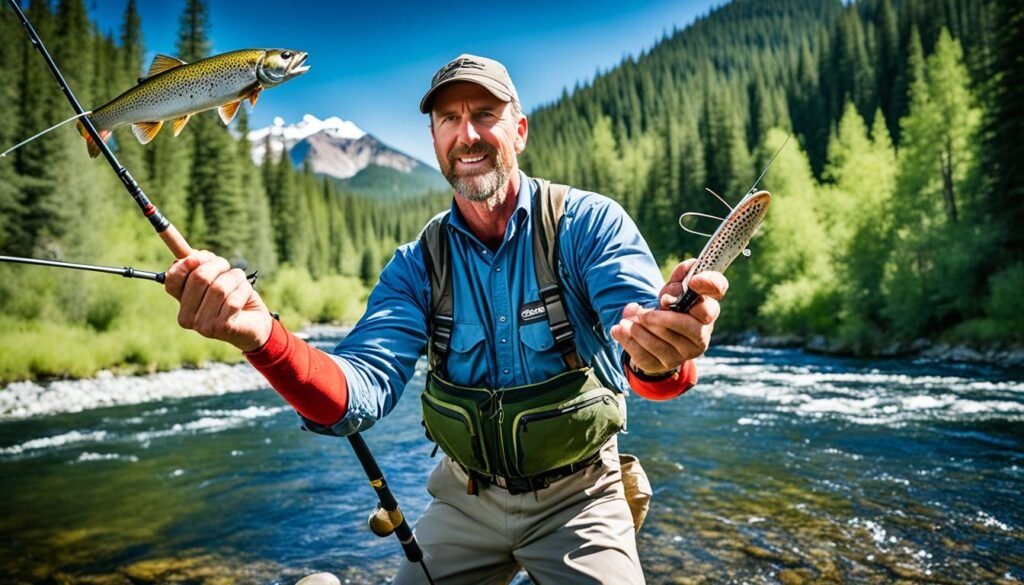
| Rod Length | Line Weight | Recommendation |
|---|---|---|
| 11′ | 3wt | A versatile option for small water situations |
| 10’6″ | 4wt | Ideal for larger rivers and average-sized trout |
| 11’6″ | 5wt | Great for casting larger flies and targeting larger trout |
Selecting the Right Reel for Trout Spey
Choosing the right reel for trout spey fishing is as vital as the right rod. The reel holds your line and backing. It also adds balance and improves your casting. Here’s what you should consider when picking a reel for trout spey fishing:
Reel Weight and Balance
For the best casting performance, your reel’s weight and balance are key. Pick a reel that’s a bit heavier than your trout spey rod by about two line sizes. This balance helps with the longer rod without making things bulky.
A well-balanced reel feels better to hold and improves your casting accuracy. It makes your gear more responsive. This means your casting will be smoother and easier.
Trout spey rods are light and fragile compared to larger ones. Your reel choice should match this, creating a well-balanced set.
Choosing the Appropriate Reel
Consider these points when choosing a reel for trout spey fishing:
- Drag System: Choose a reel with a smooth, adjustable drag system. It should help you handle big fish smoothly.
- Reel Capacity: Your reel must have enough space for your fly line and backing. This prevents tangles and makes line retrieval easy.
- Durability and Construction: Pick a reel that is well-made from quality materials. This ensures it will last through many fishing trips.
Comfort During Casting
Since trout spey fishing involves lots of casting, make sure your reel is comfortable to use. Look for a design that feels good in your hand with smooth operation. It should help reduce fatigue during long days of fishing.
Your reel is like an extension of your arm when casting. It should operate smoothly to make fishing enjoyable and productive.
Think about the reel’s weight, balance, and comfort when picking one for your trout spey rod. A well-chosen reel, when matched with the right rod and line, can boost your casting and control. This increases your chances of catching more fish.
Next, we will look at setting up your fly line for trout spey fishing. We’ll cover backing, running line, shooting heads, and more.

Understanding the Fly Line Setup for Trout Spey
The setup for trout spey is a bit more complex than single-handed setups. It includes backing, running line, shooting head, leader, and tippet. Each piece does something important for how well your setup works.
Backing
Backing is the first part of trout spey fly line setup. It’s like a reserve line tying your fly line to the reel. Backing gives extra length and strength. This helps prevent big fish from taking too much line or going too far away.
Running Line
The running line is the thin line for casting. It’s usually made of monofilament or nylon. This material lets the line move easily and quickly. Choosing the right running line helps in casting and matching with the shooting head.
Shooting Head
The shooting head is vital for trout spey. It changes how well you can cast and how your fly looks to fish. Two main kinds are used: skagit and scandi.
Skagit heads are for heavy flies and cast powerfully. They work best in smaller areas. This makes them great for casting streamers and handling big setups.
Scandi heads work well with lighter flies and longer casts. They’re good for calm, clear waters. They add finesse to your casting.
Leader and Tippet Rigging
Leaders and tippets are as important in spey fishing as in single-handed. The leader connects the shooting head to your tippet smoothly. Picking the right leader size and strength matters a lot.
For tippet rigging, think about the flies and water. Pick from materials like monofilament or fluorocarbon. This choice depends on fish conditions and what you like.
Choosing the Right Tip and Sink Rate
Choosing the right tip and its sink rate is crucial. Tips change the fly’s depth and how it moves in water. They come in different lengths and sinks so you can match them to different waters and fish.
For success in spey fishing, getting the tip and sink rate right is key. Think about the water’s depth and movement. Also, consider what the fish like. The right tip and sink rate will get your fly to the perfect spot.
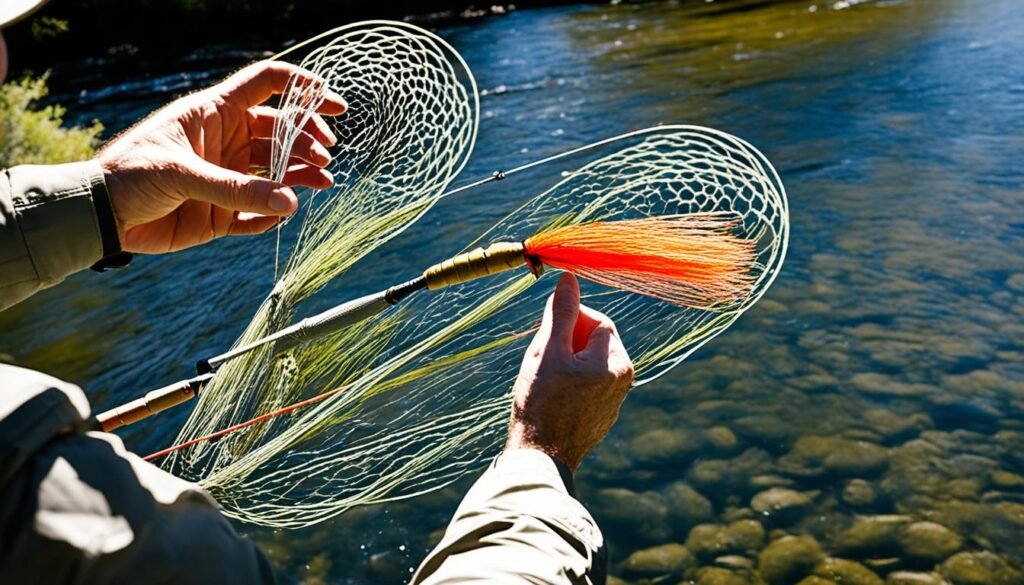
Getting the trout spey fly line setup right is essential for fishing success. By carefully choosing components and wisely matching them, you can make your flies move just the way you want. This increases your chances of hooking trout with a spey rod.
Conclusion
Learning switch casting for tight spots can level up your fly fishing, especially in small areas. Switch rods are great because they offer flexibility. They let you try different fishing styles. Trout spey rods are ideal for catching trout. They are light and make fishing enjoyable.
It’s key to get your loops right for accurate casts. Practice hand movements and use hauling to control your loops. This helps in making your casts precise.
Choosing the right equipment for switch casting and trout spey fishing is crucial. Look at the rod length, line weight, reel, and fly line setup. The right equipment will improve your cast and fishing.
Switch casting in small areas, mastering the technique, and using trout spey all help improve your fly fishing. Keep practicing and honing your skills. Enjoy the process as you get better.
FAQ
What is switch casting?
Switch casting is a neat skill for making precise casts in small areas. It’s very handy in tight spots.
How can switch casting help in small areas?
It lets you fish in little places that are hard to reach. These spots might be too tiny for regular fishing gear.
How can switch rods improve spey casting skills?
A switch rod helps with your spey casting year-round. It makes you better at casting accurately and smoothly.
What is loop control?
Loop control means you can shape the size and form of your cast’s loop. It really makes a difference in how well you cast.
How can I practice loop control?
To get better at loop control, cast through a Hula Hoop first. Then, work on your hand movements with the rod as well.
What grip should I use for tighter loops in switch casting?
Hold the rod with your index finger on top for better loop control. This keeps your rod moving straight for tight loops.
What is trout spey?
Trout spey is about using lighter two-handed rods for trout fishing. These rods are lighter and easier to handle.
How do I choose the right trout spey rod?
Think about the water and fish size first. Then, pick a rod that’s between 1wt to 5wt and 10’6″ to 11’6″ long.
What reel should I use for trout spey?
For trout spey, use a reel that’s a bit heavier than your rod. It helps balance your gear without being too heavy.
What is the fly line setup for trout spey?
Trout spey lines include backing, running line, a shooting head, and a leader. For streamers, use Skagit lines; for wetflies, go with Scandi lines.

